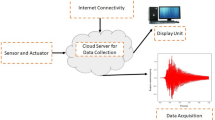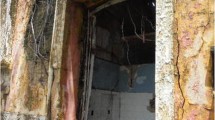Abstract
Wireless structural health monitoring (SHM) represents an emerging paradigm in non-destructive testing evaluation, which is regularly performed within the framework of structural maintenance of critical infrastructure. While traditional cable-based SHM strategies have largely relied on centralized structural response data collection and processing, in wireless SHM the sensor nodes essentially operate as stand-alone processing units. Furthermore, the on-board processing capabilities of wireless sensor nodes have been widely exploited for decentralizing SHM tasks, thus avoiding power-consuming wireless transmission of entire structural response data sets. Evidently, on-board processing requires approaches tailored to the limited computational resources of wireless sensor nodes, particularly for computationally intensive, state-of-the-art strategies for SHM that rely on artificial intelligence (AI). Specifically, in model-based SHM/AI strategies, AI algorithms are trained by running the so-called what-if scenarios using numerical models of monitored structures. However, the use of numerical models in a decentralized wireless SHM scheme might be prohibitive from a computational resources point of view. To overcome this limitation, analytical modeling techniques using elastic waveguides are developed here that carry a low computational burden. These are specifically tailored for flexible structures of variable cross section, which comprise typical components of critical infrastructure such as masts, antennas and pylons, and can be used for simulating axial, torsional and flexural vibrations. The accuracy and efficiency of the proposed analytical modeling approach are then demonstrated through comparisons with conventional numerical models based on the finite element method.












Similar content being viewed by others
References
O’Rourke, T.D.: Critical infrastructure, interdependencies, and resilience. The Bridge 37(1), 22–29 (2007)
Smarsly, K., Law, K.H.: A migration-based approach towards resource-efficient wireless structural health monitoring. Adv. Eng. Inform. 27(4), 625–635 (2013)
Adams, D.E.: Health Monitoring of Structural Materials and Components: Methods with Applications. Wiley, Hoboken (2007)
Smarsly, K., Lehner, K., Hartmann, D.: Structural health monitoring based on artificial intelligence techniques. In: Proceedings of the International Workshop on Computing in Civil Engineering, 24 July 2007, Pittsburgh, PA, USA (2007)
Ellingwood, B.R., Naus, D.J.: Condition assessment and maintenance of aging structures in critical facilities, a probabilistic approach. In: Frangopol, D.M. (ed.) Case Studies in Optimal Design and Maintenance Planning of Civil Infrastructure Systems, pp. 45–56. ASCE Structural Engineering Institute, Reston (1999)
Ching, J., Muto, M., Beck, J.L.: Structural model updating and health monitoring with incomplete modal data using Gibbs sampler. Comput. Aided Civ. Infrast. Eng. 21(4), 242–257 (2006)
Ying, Y., Garret, J.H., Oppenheim, I.J., Soibelman, L., Harley, J.B., Shi, J., Jin, Y.: Toward data-driven structural health monitoring: application of machine learning and signal processing to damage detection. ASCE J. Comput. Civ. Eng. 27(6), 667–680 (2013)
Housner, G.W., Bergman, L., Caughey, T., Chassiakos, A., Claus, R., Masri, S., Skelton, R., Soong, T.T., Spencer, B.F., Yao, J.T.P.: Structural control: past, present, and future. ASCE J. Eng. Mech. 123(9), 897–974 (1997)
Nagarajaiah, S., Dyke, S., Lynch, J.P., Smyth, A., Agrawal, A., Symans, M., Johnson, E.: Current directions of structural health monitoring and control in USA. Adv. Sci. Technol. 56, 277–286 (2008)
Rodič, B.: Industry 4.0 and the new simulation modeling paradigm. Organizacija 50(3), 193–207 (2017)
Dragos, K., Smarsly, K.: Decentralized infrastructure health monitoring using embedded computing in wireless networks. In: Sextos, A.G., Manolis, G.D. (eds.) Dynamic Response of Infrastructure to Environmentally Induced Loads, pp. 183–201. Springer International Publishing AG, Cham (2017)
Farrar, C.R., Worden, K.: Structural Health Monitoring: A Machine Learning Perspective. Wiley, Hoboken (2012)
Dragos, K., Smarsly, K.: Distributed adaptive diagnosis of sensor faults using structural response data. Smart Mater. Struct. 25(10), 105019 (2016)
Villaverde, R.: Fundamental Concepts in Earthquake Engineering. CRC Press, Boca Raton (2009)
Kausel, E.: Advanced Structural Dynamics. Cambridge University Press, Cambridge (2017)
Flugge, W.: Viscoelasticity. Blaisdell Publishing Company, Boston (1967)
Manolis, G.D., Stefanou, G.S., Markou, A.A.: Dynamic response of buried pipelines in randomly structured soil. Soil Dyn. Earthq. Eng. 128, 1–11 (2020)
Graff, K.F.: Wave Motion in Elastic Solids. Ohio State University Press, Athens (1975)
Deraemaeker, A., Reynders, E., De Roeck, G., Kullaa, J.: Vibration-based structural health monitoring using output-only measurements under changing environment. Mech. Syst. Signal Process. 22(1), 34–56 (2008)
Belver, A.V., Iban, A.L., Rossi, R.: Lock-in and drag amplification effects in slender line-like structures through CFD. Wind Struct. 15(3), 189–208 (2012)
Manolis, G.D., Markou, A.A.: A distributed-mass structural system for soil–structure interaction and base isolation studies. Arch. Appl. Mech. 82, 1513–1529 (2012)
Lynch, J.P., Loh, K.J.: A summary review of wireless sensors and sensor networks for structural health monitoring. Shock Vib. Dig. 38(2), 91–128 (2006)
Zimmerman, A.T., Shiraishi, M., Swartz, R.A., Lynch, J.P.: Automated modal parameter estimation by parallel processing within wireless monitoring systems. ASCE J. Infrastruct. Syst. 14(1), 102–113 (2008)
Java, Oracle Corp., Redwood Shores, CA, USA (1996) www.java.com
C++, ISO/IEC Joint Technical Committee 1, Geneva, Switzerland (1987) https://www.iso.org/isoiec-jtc-1.html
Python Software Foundation, Beaverton, OR, USA (2001) www.python.org
Ellingwood, B.R.: Risk-informed condition assessment of civil infrastructure: state of practice and research issues. Struct. Infrastruct. Eng. 1(1), 7–18 (2007)
Polyanin, A.D., Zaitsev, V.F.: Handbook of Exact Solutions for Differential Equations. Chapman and Hall, Boca Raton (2003)
Gradshteyn, I.S., Ryzhik, I.M.: Table of Integrals, Series and Products. Academic Press, New York (1980)
Press, W.H., Flannery, B.P., Teukolsky, S.A., Vetterling, W.T.: Numerical Recipes. Cambridge University Press, Cambridge (1989)
Kiusalaas, J.: Numerical Methods in Engineering with Python, 2nd edn. Cambridge University Press, Cambridge (2010)
SAP 2000, Integrated Software for Structural Analysis and Design, Version 21, Computers and Structures, Inc., Berkeley, CA, USA (1975) https://www.csiamerica.com/products/sap2000
Acknowledgements
The authors wish to acknowledge financial support from the German Research Foundation (DFG) program on Initiation of International Collaboration entitled “Data-driven analysis models for slender structures using explainable artificial intelligence” Project Number SM 281/14-1 for the period 2019–2021, with Prof. Dr.-Ing. Kay Smarsly, Bauhaus University Weimar, as the project coordinator.
Author information
Authors and Affiliations
Corresponding author
Additional information
Publisher's Note
Springer Nature remains neutral with regard to jurisdictional claims in published maps and institutional affiliations.
Appendix
Appendix
In this Appendix, we list a typical software package developed in the Python programming environment [26] for axial vibrations. It computes the eigenvalue problem and the transient response based on modal analysis for the tapered pylon.
# Axial Vibrations for Tapered Pylons | |
# Python External Libraries | |
import numpy as np | |
# Building of Local Libraries | |
from Boundaries import * | |
from NR_solver import * | |
from Normalization import * | |
from Plot_Eigenfunction import * | |
from Gen_Values import * | |
from Plot_u_xt import * | |
from Plot_u_xf import * | |
# Compute cross-sectional area | |
def A(x): | |
\(\hbox {Aa} = 2\)*np.pi*Ra*t | |
return Aa*(x/a)**2 | |
# Compute mass and stiffness \(\rho \mathrm{A}\), \(\mathrm{E}\mathrm{A}\) | |
def wg(x): | |
return d*A(x), E*A(x) | |
# Compute constants appearing in each eigenfunction as C2/C1 | |
\(\hbox {C}=[]\) | |
for k in k: | |
C.append(-np.tan(k*b)) | |
return C | |
# Computation of eigenfunctions | |
def f(c,C,k,x): | |
\(\hbox {return c/x *(np.sin(k*x)}+\hbox {C*np.cos(k*x))}\) | |
# Computation of first spatial derivative of eigenfunctions | |
def df(c,C,k,x): | |
return ( | |
\((-\hbox {c}/\hbox {x**2})\hbox {*}(\hbox {np.sin(k*x)}+\hbox {C}*\hbox {np.cos(k*x))}\) | |
\(+(\hbox {c}*\hbox {k/x}*(\hbox {np.cos(k*x)}-\hbox {C*np.sin(k*x)))\quad )}\) | |
# Computation of the characteristic equation | |
def Eq(x): | |
\(\hbox {return 1/a*np.sin(x*L)}+\hbox {x*np.cos(x*L)}\) | |
# Computation of the first derivative of the characteristic equation | |
def dEq(x): | |
\(\hbox {return 1/a*L*np.cos(x*L)}+\hbox {np.cos(x*L)-x*L*np.sin(x*L)}\) | |
if __name__\(==\)”__main__”: | |
# Input Values |
\(\hbox {E} = 44.4\)*10**6 | |
\(\hbox {d} = 2.55\) | |
\(\hbox {Ra} = 0.2150\) | |
\(\hbox {Rb} = 0.3375\) | |
\(\hbox {t}= 0.0875\) | |
\(\hbox {L}= 10.0\) | |
# The slope at the boundaries requires the value of the radius at the top Ra | |
# at the bottom Rb, and the length computed from \(\hbox {a}=39.54\) and \(\hbox {b}=49.54\) | |
# For constant cross section then \(\hbox {a}=0 \kappa \alpha \iota \hbox {b}=\hbox {L}\) | |
a, \(\hbox {b}=\hbox { boundaries(Ra, Rb, L)}\) | |
# Routine roots() uses the Newton–Raphson method to solve the characteristic equation | |
# Requires the characteristic eqn and its first derivative plus 4 values close to | |
# the roots. Solves for the first 4 wave numbers | |
\(\hbox {k} =\hbox { roots(Eq, dEq, [0.20, 0.50, 0.80, 1.10])}\) | |
# Routine constant()requires the wave number and returns constant | |
# C equal to C2/C1 | |
\(\hbox {C} =\hbox { constant(k)}\) | |
# Routine norm() requires eigenfunction f, constants C2/C1, | |
# the length as either b-a or L, and the wave numbers k | |
# It returns constants c for normalizing the eigenfunction to unity | |
\(\hbox {c} =\hbox { norm(f, a, C, k)}\) | |
# Routine plot_3d_Eig() requires the eigenfunction f, its first derivative, | |
# the waveguide ends (a,b), normalization constants c, ratios C2/C1, C3/C1, etc., | |
# wavenumbers k, the input loading function and the radii at top and bottom as | |
# Ra, Rb. It plots the first 4 eigenfunctions as x-y plots and as 3D plots | |
plot_3d_Eig(f,df, (a,b), c, C, k, ’axial’, Ra, Rb) | |
# Routine gen_Values() requires the eigenfunction f, its first derivative, the | |
# weight functions wg, the end coordinates (a,b), the normalization constants c, | |
# constants C from the list C, and the wavenumbers k | |
# It returns values for the generalized mass M, generalized stiffness K, | |
# the generalized external force P, and the eigenvalues W | |
\({\hbox {W,M,K,P}} ={\text {gen\_Values(f, df, wg, (a,b), c, C, k)}}\) | |
# Routine plot_u_xt_, requires the generalized mass \(\mathrm{M}\), the generalized force P, | |
# the eigenfrequencies W, and the external load frequencies. Here we use values of | |
# [100 Hz, 300 Hz, 500 Hz, 700 Hz]. Output are Displacement versus Time curves | |
plot_u_xt_(M, P, W, [100, 300, 500, 700]) | |
# Routine plot u_xf is similar and plots Displacement versus Frequency [0–800 Hz] | |
# There is a 0.20 mm cut-off point for the displacement u, to avoid division | |
# by zero when we have tuning | |
plot_u_xf_(K, P, W, [800, .20]) |
Rights and permissions
About this article
Cite this article
Manolis, G.D., Dadoulis, G.I., Pardalopoulos, S.I. et al. Analytical modeling of flexible structures for health monitoring under environmentally induced loads. Acta Mech 231, 3621–3644 (2020). https://doi.org/10.1007/s00707-020-02712-9
Received:
Published:
Issue Date:
DOI: https://doi.org/10.1007/s00707-020-02712-9




